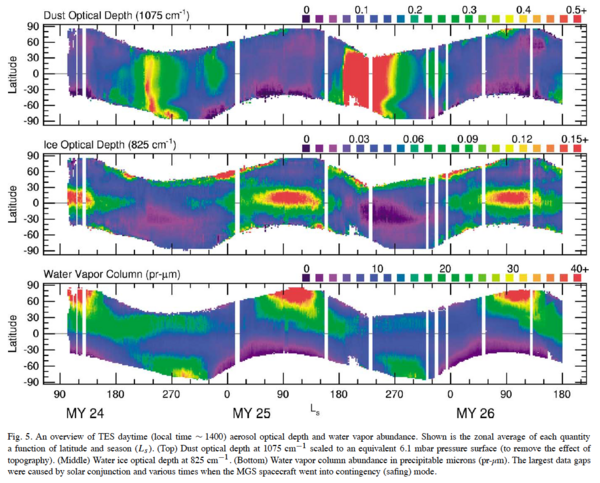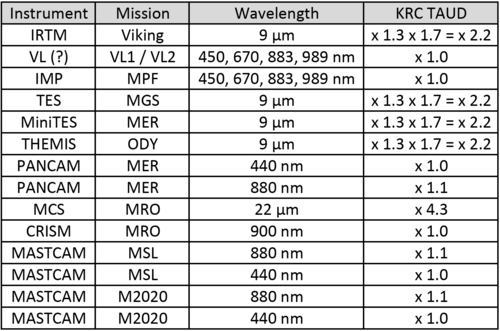Category:Dust opacity
First, a few definitions (From Helplist or communicated by HHK):
PTOTAL: Global annual mean surface pressure at 0 elev., Pascal[=.01mb]; If KPREF=2, global average of atmosphere plus cap system.
PTOTAL depends on the scale height you consider.
PTOTAL = 640Pa, 658Pa, 672Pa, 683Pa, 692Pa, 700Pa for scale heights H=7-8-9-10-11-12 km respectively. In reality, H oscillates over the course of a year.
KPREF: Mean global pressure control. 0 = constant 1 = follows Viking Lander curve 2 = reduced by global frost, but then N4 must be >8, and latitudes must be monotonic increasing and must include both polar regions (no warning for your failure).
TAUD: Opacity due to dust over solar wavelengths (weighted by solar spectral flux) for a column with pressure of PTOTAL at zero elevation. It is used in code: tlats8.f line 193, then 213. It can be over-ridden by using a climate file, in which case solar tau at PTOTAL is IR_opacity (from the file) / TAURAT
- If your dust opacity TAU is given for a pressure = PTOTAL (usually the case for TES/THEMIS), you do not have to scale for a different pressure.
For example, in Smith 2003, Figure 5:
Caption:Fig. 5. An overview of TES daytime (local time ∼ 1400) aerosol optical depth and water vapor abundance. Shown is the zonal average of each quantity a function of latitude and season (Ls ). (Top) Dust optical depth at 1075 cm-1 scaled to an equivalent 6.1 mbar pressure surface (to remove the effect of topography). (Middle) Water ice optical depth at 825 cm-1. (Bottom) Water vapor column abundance in precipitable microns (pr-μm). The largest data gaps were caused by solar conjunction and various times when the MGS spacecraft went into contingency (safing) mode.
In other words, if you are using a dust opacity scaled to a specific pressure = PTOTAL, no topographic correction is needed.
- If your dust opacity value is NOT given for a pressure of PTOTAL (usually the case for rovers and landers), you must first scale it to PTOTAL.
- 1 Calculate the local pressure P(z):
P0 is the reference pressure, also called PZREF. In theory, this is not PTOTAL, because the reference pressure too oscillates with Ls.
z is the elevation where the opacity measurement is made (VL1=-3.63,VL2=-4.50km, MPF=-3.68km,Spirit=-1.94km,Opportunity=-1.39km,MSL=-4.5km,InSight=-2.7km).
Z0 is the reference elevation for PTOTAL, so typically 0km.
H is the scale height in km.
- 2 Adjust the local dust opacity
The Opacity TAU at PTOTAL can then be derived using the following relation (M. Smith):
Note that if an opacity vs. Ls is provided, TAU is the visible opacity at a pressure of PTOTAL.
- 3 Adjust for wavelength
Dust opacities are given at different wavelengths in the literature. KRC works with opacity values at solar wavelengths. Use the table below to convert published opacity values to the best estimate for the visible wavelength opacity
Smith, M. D. (2004), Interannual variability in TES atmospheric observations of Mars during 1999-2003, Icarus, 167, 148-165.
This category currently contains no pages or media.


